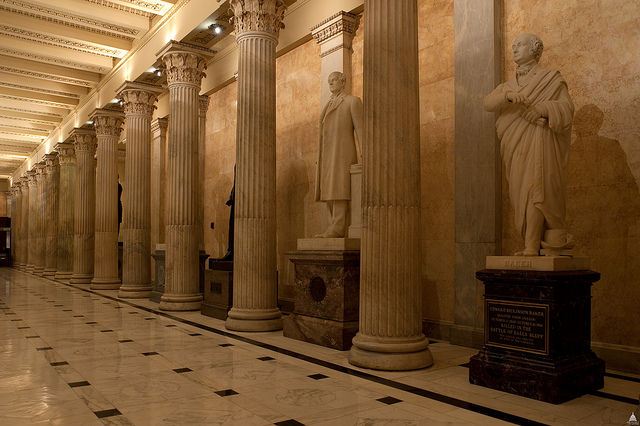
The SCRUB Act would help eliminate duplicative rules through retrospective review.
The House Judiciary Committee recently released draft legislation to address regulatory duplication. The Searching for and Cutting Regulations that are Unnecessarily Burdensome Act – known simply as the SCRUB Act – would establish an independent commission to examine rules that “are not justified by the benefits.” Scrutinizing duplication through retrospective review is a critically important task, but one that, to date, has only proceeded in piecemeal fashion.
The most significant regulatory burdens do not arise merely because of a single rule. Rather, businesses and individuals must confront the cumulative effects of a variety of regulations issued by different agencies across separate administrations. The problem is that we simply do not know the primary areas of regulatory accumulation and duplication. The public can decipher and analyze decades of tax data and the economic implications for certain rates and credits, but the regulatory world is practically a black box compared to fiscal policy.
At the very least, everyone interested in regulatory policy should want more information: more data on costs, benefits, distributional impacts, and employment effects. Are there certain regulations that impose huge barriers to innovation and obstacles for start-up companies? We generally do not know, and this is a problem that Congress and the administration must address.
All sides in the political and policy debate acknowledge at least some level of duplication in the federal government. For example, several U.S. Senators have established a bipartisan task force to “conduct a comprehensive review of federal regulations and reporting requirements affecting colleges and universities.” This task force makes sense because tuition has skyrocketed in the last decade and the paperwork burden the Department of Education has imposed on schools has increased from 43 million hours in fiscal year 2006 to more than 96 million hours in fiscal year 2011. Importantly, the task force wants to know more than just the broad numerical trends in paperwork, but actually seeks to find ways to reduce unnecessary burdens and costs.
The public knows that government duplication can take many forms. In federal spending, the U.S. Government Accountability Office (GAO) has found 17 areas of duplication, overlap, and fragmentation, from renewable energy to veterans’ employment. The cost of duplicative federal spending approaches $365 billion, according to one account of the GAO’s study.
Regulatory overlap also has a price. Based on the areas of overlap that the GAO identified, the American Action Forum (AAF) examined the regulatory implications of duplication. AAF found 642 million paperwork hours, $46 billion in costs, and 990 forms of federal overlap associated with the paperwork requirements in the 17 areas of government duplication that the GAO listed.
Obviously, sorting through this duplication, including the more than 174,000 pages in the Code of Federal Regulations, is a daunting process. But other developed countries are actively targeting past rules for amendment or repeal. The Organization for Economic Co-Operation and Development (OECD) in Paris recommends that all nations “conduct systematic programme reviews of the stock of significant regulation.” The OECD believes such retrospective review programs can “ensure that regulations remain up to date, cost justified, cost effective and consistent, and deliver the intended policy objectives.” Establishing a commission like the one proposed in the SCRUB Act will move the U.S. beyond its current framework toward a “consistent culture of retrospective review.”
The SCRUB Act’s proposed commission would address not only costs, but also carefully scrutinize the benefits of the rules it reviews. For example, the U.S. Environmental Protection Agency recently issued a rule that the agency anticipates will result in up to $52 million in environmental “disbenefits” from dirtier air and water. Under the current system, there is no guarantee this rule will be reviewed and amended.
The SCRUB Act would require a commission to examine rules where benefits may no longer justify the costs. By extension, rules that the commission finds that produce benefits that vastly exceed their costs are unlikely be repealed. Indeed, if the commission finds such rules, regulators should be able to learn better how to regulate in the future. Armed with knowledge of the actual effects of their regulations, regulatory officials can replicate the design of regulations that have continued to produce substantial net benefits, and they can avoid rules that continue to generate significant economic burdens for few, if any, benefits.
As far back as the Carter Administration, presidents have issued executive orders on regulatory reform, repeatedly calling on agencies to review regulations on the books to determine if they are still generating net benefits. Yet, executive order after executive order has left both progressives and conservatives outraged at the regulatory process. This is unfortunate because all serious policymakers, no matter their politics, should want as much information as possible about how our nation’s regulatory apparatus is working. Legislation like the SCRUB Act, which is designed to enhance our understanding of the regulatory world and reduce duplicative rules, should be applauded by everyone.
This essay is part of The Regulatory Review’s five-part series, Debating the Independent Retrospective Review of Regulations.
Pictured in the text is the Hall of Columns, which is situated in the House wing of the U.S. Capitol Building and is located below the Hall of the House of Representatives. Photo Credit: Architect of the Capitol.




